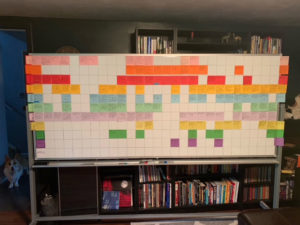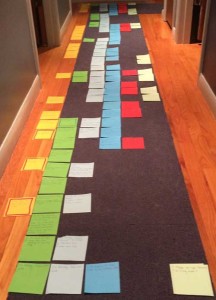Rainbow is Wide, Rainbow is Long
![]() The plot rainbow is constructed from rows and columns. Which is which largely depends on whether we’ve laid it out on the floor or on our snazzy new whiteboard. But either way, a stripe of any given color represents an entity’s timeline, and a stripe that cuts across all the colors perpendicularly is a story beat.
The plot rainbow is constructed from rows and columns. Which is which largely depends on whether we’ve laid it out on the floor or on our snazzy new whiteboard. But either way, a stripe of any given color represents an entity’s timeline, and a stripe that cuts across all the colors perpendicularly is a story beat.


Generally, we build up the rainbow by beats. “What’s everybody up to at this point in the story?” This approach feels natural for us during the early to middle phases, while the structure is incomplete. But once we have most of it set up, we find it very useful to run through each color the whole way from start to finish. Often cards will get added this way that had been missed during the beat-by-beat phases.
It’s important not to start thinking you have to fill in every space in the grid. Only create cards for the information that matters. It needn’t be anything that will become an actual scene, though. And by following each character’s journey all the way through the overall tale we make sure that their story arcs all make sense. In effect, we’re going through the whole cast in turn and asking what the novel would look like if they were the main character. Coming at it from these different angles really helps find the places where things might not join up smoothly, and it’s super easy to make adjustments to the rainbow. Much more so than in rewrites!
A writing partner is someone to criss-cross the rainbow with you.
